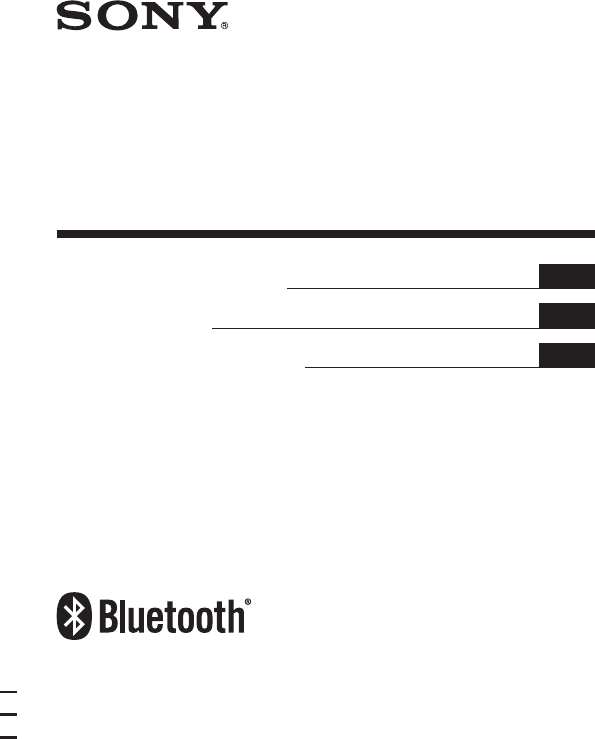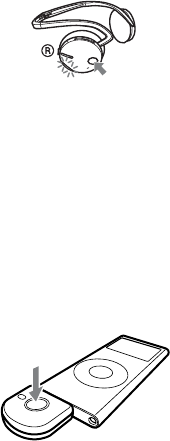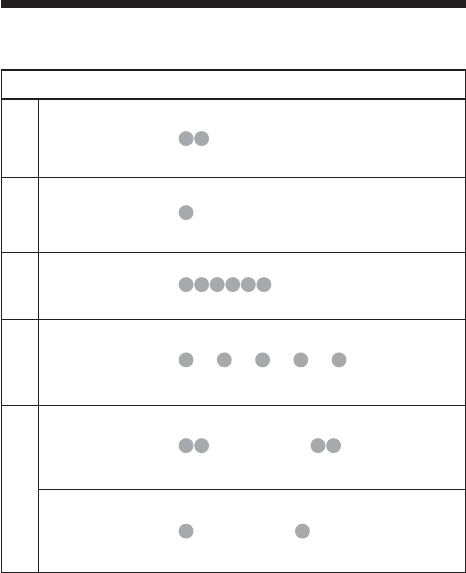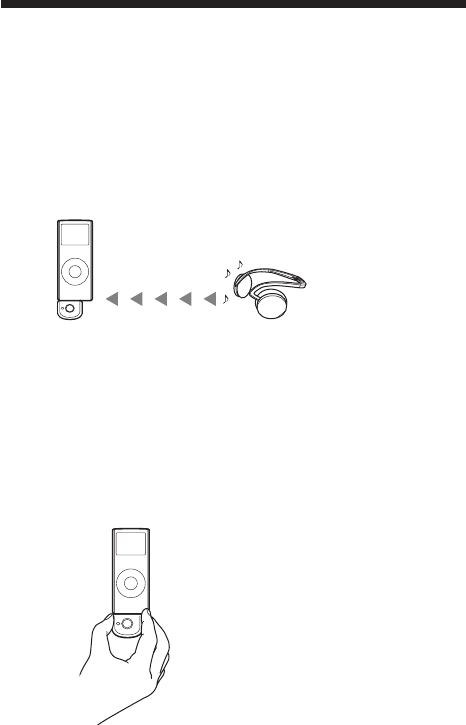Sony Group TMRBT8IP Bluetooth Adapter User Manual HDX 2013
Sony Corporation Bluetooth Adapter HDX 2013
User Manual

Operating Instructions US
Mode d’emploi FR
Manual de instrucciones ES
Stereo Transmitter
© 2007 Sony Corporation
TMR-BT8iP
3-279-360-31 (1)

2US
WARNING
To reduce the risk of re or
electric shock, do not expose this
apparatus to rain or moisture.
iPod is trademark of Apple Computer, Inc.,
registered in the U.S. and other countries
e Bluetooth word mark and logos are
owned by the Bluetooth SIG, Inc. and any
use of such marks by Sony Corporation is
under license.
Other trademarks and trade names are those
of their respective owners.
INFORMATION:
is device complies with Part 15 of FCC
Rules and RSS-Gen of IC Rules. Operation is
subject to the following two conditions: (1)
this device may not cause interference, and
(2) this device must accept any interference,
including interference that may cause
undesired operation of this device.
You are cautioned that any changes or
modications not expressly approved in this
manual could void your authority to operate
this equipment.
is equipment must not be co-located or
operated in conjunction with any other
antenna or transmitter.
is equipment complies with FCC/IC
radiation exposure limits set forth for
uncontrolled equipment and meets the FCC
radio frequency (RF) Exposure Guidelines in
Supplement C to OET65 and RSS-102 of the
IC radio frequency (RF) Exposure rules. is
equipment has very low levels of RF energy
that it is deemed to comply without testing of
specic absorption ratio (SAR).
iPod nano 2nd
generation
(aluminium)
Compatible iPod models
The compatible iPod models are as
follows. Update your iPod to use
the latest software before you use it.
iPod 5th
generation (video)
iPod nano
1st generation iPod 4th
generation
(color display)
iPod 4th
generation
iPod mini
1st generation
Notes
is unit is designed for iPod only. You
cannot connect any other portable audio
players.
Sony cannot accept responsibility in the
event that data recorded to iPod is lost or
damaged when using an iPod connected
to this unit.

3
US
US
Table of Contents
What is Bluetooth wireless
technology? ............................ 4
Features ..................................... 5
Basic operation of Bluetooth
devices ..........................................6
Getting Started
Location and
Function of Parts ................... 7
Connecting to an iPod ............. 8
Pairing ..................................... 10
What is pairing? ..........................10
Pairing procedures......................10
On Indicators .......................... 13
Listening to music
Bluetooth Connecting /
Playing back ......................... 14
Controlling by the Remote .... 16
Additional Information
Precautions ............................. 17
Troubleshooting ..................... 19
Initializing this unit ............... 21
Specications .......................... 22

4US
What is Bluetooth wireless technology?
Bluetooth
®
wireless technology is a short-range wireless technology
that enables wireless data communication between digital devices,
such as a computer or digital camera. Bluetooth wireless technology
operates within a range of about 10 meters (about 30 feet). Connecting
two devices as necessary is common, but some devices can be
connected to multiple devices at the same time.
You do not need to use a cable for connection nor is it necessary for the
devices to face one another, such is the case with infrared technology.
For example, you can use such a device in a bag or pocket.
Bluetooth standard is an international standard supported by thousands
of companies all over the world, and employed by various companies
worldwide.
Communication System and Compatible Bluetooth Prole
of this unit
Prole is standardization of the function for each Bluetooth device
specication. is unit supports the following Bluetooth version and
proles:
Communication System: Bluetooth Specication version 2.0 + EDR*
Compatible Bluetooth Prole:
–
A2DP (Advanced Audio Distribution Prole)
–
AVRCP (Audio/Video Remote Control Prole)
* Enhanced Data Rate
Notes
To be able to use the Bluetooth function, the Bluetooth device to be connected
requires the same prole as the unit’s.
Note also that even if the same prole exists, devices may vary in function
depending on their specications.
Due to the characteristic of Bluetooth wireless technology the sound transmitted
from this unit is slightly delayed during listening to the music.

5
US
Features
is unit is an audio transmitter using Bluetooth wireless
technology.
You can enjoy music wirelessly by transmitting the audio signals
to a Bluetooth receiving device (headset, car stereo, speaker, stereo
component system, etc.), if you connect this unit to the iPod
(see page 2 on compatible iPod models) with the iPod connector
(30 pin).
is unit’s features are as follows:
Wireless transmitter for streaming of high-quality stereo music
from iPod.
Transmits music to other devices using Bluetooth wireless
technology.*1
Basic remote control operation (play, pause, etc.) of iPod
functions via Bluetooth connection.*2
Transmitter power supplied from iPod so no additional battery or
charging is needed.
*1 e connected Bluetooth device is required to support A2DP(Advanced Audio
Distribution Prole).
*2 The connected Bluetooth device is required to support AVRCP(Audio Video
Remote Control Profile).
iPod with dock
connector port
(30 pin)
This unit
Bluetooth headset, etc.
Tip
For details on Bluetooth technology, see page 4.

6US
Basic operation of Bluetooth devices
e following example describes how you can transmit music
played on an iPod connected to this unit, and listen on a Bluetooth
receiving device (headset).
Pairing
Enables a Bluetooth receiving device and this unit to recognize one another.
You do not need to recognize one another next time if you did once.
iPod with dock
connector port
(30 pin)
This unit
Bluetooth receiving
device (headset)
Bluetooth connecting
Turn on the Bluetooth receiving device and play the iPod. Bluetooth
connection is established automatically.
Listening to music
You can enjoy listening to music played on your iPod connected to this unit
through the Bluetooth receiving device.
For more details, see page 13.
For more details, see page 13.
For more details, see page 10.

7
US
Getting Started
Location and Function of Parts
iPod connector
(30 pin)
Connects to the
dock connector of an iPod
(page 8).
Indicator
Indicates this unit’s status
(page 12).
Power button
Performs the following:
• Turning on/o of this unit
(page 8).
• Pairing (page 10).
• Initializing this unit
(page 20).

8US
Connecting to an iPod
Connect this unit to the dock connector port of an iPod rmly.
Dock connector port (30 pin)
Power button
To turn on this unit
1
Connect this unit to the iPod.
2
Press the power button of this unit for about 1 second to turn it on,
or start to play back on iPod.
When this unit turns on, the indicator ashes twice.
Note
If the unit cannot turn on, operate the iPod.
To turn o this unit
To turn o this unit, press and hold this unit’s power button for
about 2 seconds. e indicator ashes once and this unit turns o.
Tip
Maximum communication time or standby time may vary depending on your
iPod.
Notes
To listen to music from the headphone jack of the iPod, disconnect this unit from
the iPod.
While this unit is turned on, it consumes power from the iPod. We recommend
disconnect this unit from iPod when not using the Bluetooth function.
If the headphone is connected to the iPod while the iPod is playing back, it
consumes power from iPod.
If you turn o this unit while the iPod is playing back, iPod will power o.
9
US
It is not recommended to turn o iPod as the linkage will lost between this unit
and the Bluetooth receiving device.
Do not press of the iPod for more than 2 seconds, it will power o this unit
and iPod.
ere is no need to charge this unit as it will receive power from the connected
iPod. It is recommended to check the iPod’s remaining battery before using.

10 US
Pairing
What is pairing?
Bluetooth devices need to be “paired” with each other beforehand.
Once Bluetooth devices are paired, there is no need for pairing
again, except in the following cases:
Pairing information is deleted aer repair, etc.
is unit is paired with 9 or more receiving devices.
is unit can be paired with up to 8 Bluetooth receiving device. If a
new device is paired aer 8 devices have been paired, the device whose
latest connection time is the oldest among the 8 paired devices is
replaced by the new one.
is unit is initialized.
All pairing information is deleted (page 20).
Pairing procedures
1
Turn on the power of iPod.
(Make sure the iPod is in pause mode)
2
Connect this unit to the iPod (page 8).
3
Place this unit and the Bluetooth receiving device to be paired
together within 1 m (3 ft).
4
Set
the Bluetooth receiving device to enter “Pairing in process.”
See the operating instructions supplied with the Bluetooth receiving
device.
Tip
For Sony Wireless Stereo Headset

11
US
Press and hold the POWER button of the bluetooth receiving
device for 7 seconds or more to standby for pairing while the
unit is turned o.
Note
Passcode* of this unit is xed at “0000”, “1234” or “8888.” Depending on the
Bluetooth receiving device, it may be necessary to input the passcode (in this
case, “0000”, “1234” or “8888”). is unit cannot be paired with a Bluetooth
receiving device whose passcode is not “0000”, “1234” or “8888.”
* Passcode may be called “Passkey,” “PIN code,” “PIN number,” or “Password.”
5
Press
and hold the power button of this unit for more than about 7
seconds to enter “Pairing in process.”
Aer about 1 second, the indicator will ash twice but keep
pressing the POWER button.
Note
When rst power on this unit a er initialize, this unit will enter the “Pairing
in process” automatically.
When the indicator of this unit ashes quickly, stop pressing it.
is unit enters “Pairing in process.”
is unit’s indicator status will vary as follows, and pairing is
established with the Bluetooth receiving device.
12 US
Indicator ashes quickly: Pairing in process
Indicator ashes
(at about 1-second interval)
when responding to
the Bluetooth receiving device
: Connectable
.
(Paring successful)
Indicator ashes (at about 5-second intervals): Connected
Notes
“Pairing in process” of this unit is released a er about 5 minutes. If pairing is
not established within about 5 minutes, repeat the above procedure from step
4
.
To enter “Pairing in process,” you need to turn o the power of this unit and
turn on the power of iPod rst.
When not completed pairing
Repeat the procedure from step
2
.
To quit “Pairing in process”
Press and hold the POWER button of this unit for about 2 seconds
to turn o this unit.
Tip
When paring this unit with a number of Bluetooth receiving devices, repeat steps 3
to 5 for each device individually.
Note
For using the Bluetooth function, it is required that the Bluetooth device on the
other side is corresponding with the same pro le as this unit. However, even if it is
corresponding with the same pro le, functions may di er depending on the
speci cation of the Bluetooth device.

13
US
On Indicators
Status Indicator
Power on
Flashes twice
Power o
Flashes once
Pairing
Flashes quickly …
Connecting
Flashes
(at about 1-
second intervals)
— — — — — …
Connected
Listening *1
(ashes twice at
about 5-second
intervals)
— — — — — — — — — — …
With no music *2
(ashes once at
about 5-second
intervals)
— — — — — — — — — — …
*1 When press on the iPod, the music pause. e indicator ashes twice on this
unit. is unit transmit the data of no sound.
*2 When press the pause button on the Bluetooth receiving device, the music pause.
e indicator ashes once on this unit. is unit does not transmit the music.

14 US
Listening to music
Bluetooth Connecting / Playing back
You can listen to music of the iPod connected to this unit on the
Bluetooth receiving device (headset, etc.).
Before starting operation, complete pairing this unit and the
Bluetooth receiving device (page 10).
1
The Bluetooth receiving device is on standby for connection.
2
Connect this unit to the iPod then turn on the iPod and start
playback on the iPod.
is unit’s indicator status will vary as follows, and the Bluetooth
connection between this unit and the Bluetooth receiving device
is established.
Indicator ashes twice: Power is on
Indicator ashes (at about 1-second intervals): Connecting
in process
Indicator ashes twice slowly (at about 5-second intervals):
Connected
(Playback will start automatically)
If the Bluetooth connection is not established within 5 minutes,
this unit automatically turns itself o. In this case, turn it on
again by pressing and holding the power button for about
1 second.
Notes
If the Bluetooth connection cannot be established with the device paired
already, try pairing again.
If playback cannot start automatically, try start playback on iPod.
If you press and hold the power button on this unit for about 1 second, this
unit will connect to the iPod and start playback automatically.
15
US
Tip
You can control the volume on the Bluetooth receiving device.
(e volume of the iPod is not changed.)
Notes
Even if you control the volume on the iPod, sound from the Bluetooth receiving
device will not change.
If this unit and the Bluetooth receiving device become out of range and the
Bluetooth connection terminates, repeat the procedure from step 1.
Playback through a Bluetooth connection may cause noise, sound break, or
playback speed change depending on the location and the usage (page 17).

16 US
Controlling by the Remote
When connecting (Bluetooth connecting) to devices that
support AVRCP (Audio/Video Remote Control Prole)
You can control the iPod using the control button of the Bluetooth receiving device.
For details, see the operating instructions supplied with the Bluetooth devices.
Before starting remote control operation, check that step 1 and 2 of
“Bluetooth Connecting / Playing back” are completed (page 13).
Remote control for the iPod by the Bluetooth receiving device.
Remote control
(play, pause, etc.)
Headset with AVRCP
Notes
Even if you control the volume on the iPod, the volume of the Bluetooth
receiving device, such as a headset, does not change.
When operating the iPod by remote control, do not cover this unit with hands.
You may need to press the play/pause button twice depending on the Bluetooth
receiving device.
You may need to press the play/pause button of the Bluetooth receiving device
twice when you operate the button on the iPod.
Operation of the iPod with this unit by the Bluetooth receiving device will vary
depending on the Bluetooth receiving device’s specification.
Do not cover this
unit with hands.

17
US
Precautions
On Bluetooth communication
Bluetooth wireless technology
operates within a range of about 10
meters (about 30 feet). Maximum
communication range may vary
depending on obstacles (human body,
metal, wall, etc.) or electromagnetic
environment.
This unit
Limited performance
Optimal performance
Steel cabinet
e aerial of this unit is shown
as illustrated in the dotted line.
e sensitivity of Bluetooth
communication will improve by
turning the direction of the built-in
aerial to the connected Bluetooth
device.
e communication distance shortens
when the obstacles are between the
aerial of the connected device and
this unit.
Location of
built-in aerial
Additional Information
e following conditions may cause
noise, sound break or playback speed
change.
– When using inside the metal bag.
– When using inside the backpack or
shoulder bag.
– A device using 2.4 GHz frequency,
such as a wireless LAN device,
cordless telephone, or microwave
oven, is in use near this unit.
Because Bluetooth devices and wireless
LAN (IEEE802.11b/g) use the same
frequency, microwave interference may
occur and resulting in communication
speed deterioration, noise, or invalid
connection if this unit is used near a
wireless LAN device. In such a case,
perform the following.
–
Install this unit and Bluetooth device as
near to each other as possible.
–
If this unit is used within about
10 meters (about 30 feet) of a wireless
LAN device, turn o the wireless
LAN device.
Microwaves emitting from a Bluetooth
device may aect the operation of
electronic medical devices. Turn o
this unit and other Bluetooth devices
in the following locations, as it may
cause an accident.
–
where inammable gas is present, in
a hospital, train, airplane, or a petrol
station.
–
near automatic doors or a re alarm.
is unit supports security capabilities
that comply with the Bluetooth
standard to provide a secure
connection when the Bluetooth
wireless technology is used, but
security may not be enough depending
on the setting. Be careful when
communicating using Bluetooth
wireless technology.
18 US
We do not take any responsibility
for leakage of information during
Bluetooth communication.
Connection with all Bluetooth devices
cannot be guaranteed.
– A device featuring Bluetooth
function is required to conform to
the Bluetooth standard specied
by Bluetooth SIG, Inc. and be
authenticated.
–
Even if the connected device
conforms to the above mentioned
Bluetooth standard, some devices
may not be connected or work
correctly, depending on the features
or specications of the device.
Depending on the device to be
connected, communication may take
some time.
On safety
Do not drop, hit, or otherwise expose
the unit to strong shock of any kind.
is could damage the product.
Do not disassemble or attempt to open
any parts of the unit.
On placement
Do not place the unit in any of the
following locations.
– Direct sunlight, near a heater, or
other extremely high-temperature
location
– Dusty location
– An unsteady or inclined surface
– Location exposed to large amounts
of vibration
– Bathroom or other high-humidity
location
– In a car subject to the direct rays of
the sun
Notes on using in a car
Do not attempt to connect this unit, or
to operate this unit, an audio output
device or a car radio while driving or
waiting at a trac signal.
Cleaning
Clean the unit with a so, dry cloth,
or a so cloth lightly moistened with
a mild detergent solution. Do not use
any type of solvent, such as alcohol
or benzene, which may damage the
nish.
Others
If you have any questions or problems
concerning this unit that are not
covered in this manual, please consult
your nearest Sony dealer.

19
US
Troubleshooting
If you run into any problems using this unit, use the following
checklist and read the product support information on our website.
Should any problem persist, consult your nearest Sony dealer.
Symptom Cause / Remedy
is unit is not
turned on.
(or turns o
shortly aer
turning on.)
Press and hold this unit power button for about 1
second.
Check the remaining battery of the iPod. If the
remaining battery is not enough, charge the iPod.
Reset your iPod.
If your iPod have no content, add some content to
your iPod.
No sound
Check the connection between this unit and the
iPod.
Check that both this unit and the Bluetooth
receiving device are turned on.
Ensure that this unit is not too far from the
Bluetooth receiving device, or this unit is not
receiving interference from a wireless LAN, other
2.4 GHz wireless device, or microwave oven.
Pair this unit and the Bluetooth receiving device
again.
Low sound level
Turn up the volume of the Bluetooth receiving
device as high as possible to the extent that sound
is not distorted. For details on volume adjustment,
refer to the operating instructions supplied with the
Bluetooth receiving device.
Cannot change the
volume.
Change the volume on the Bluetooth receiving
device.

20 US
Symptom Cause / Remedy
Distorted sound
Turn down the volume of the Bluetooth receiving
device to the point where the sound is no longer
distorted. For details on volume adjustment, refer
to the operating instructions supplied with the
Bluetooth receiving device.
Turn o the EQ of iPod.
Ensure that this unit is not receiving interference
from a wireless LAN, other 2.4 GHz wireless device,
or microwave oven.
Sound break,
noise or playback
speed change
If a device that generates electromagnetic radiation,
such as a wireless LAN, other Bluetooth device(s),
or a microwave oven is nearby, move away from
such sources.
Remove any obstacle between this unit and other
Bluetooth device or move away from the obstacle.
Locate this unit and other Bluetooth device(s) as
near as possible.
Re-position or re-orient this unit.
Re-position or re-orient other Bluetooth device.
Pairing cannot be
established.
Locate this unit and other Bluetooth device(s) as
near as possible.
Check if you input correct passcode (page 11).
Bluetooth
connection cannot
be established
with a device that
has been “paired”
before.
Locate this unit and other Bluetooth device(s) as
near as possible.
is unit tries to connect with either of the last
two devices recognized before. If this unit cannot
establish the Bluetooth connection with a paired
device, operate the connecting procedures on the
Bluetooth receiving device or pair the device again.
Pairing information may be deleted. Pair the device
again.

21
US
Initializing this unit
You can reset this unit to its default and delete all pairing
information.
1
Connect the unit to the iPod while pressing and holding the power
button on the unit.
2
Continue to press and hold the power button for more than about
15 seconds.
The indicator flashes 4 times, and this unit is reset to the default
setting. All pairing information is deleted.
Note
Do not operate your iPod while initializing this unit.

22 US
Specications
* Bluetooth standard proles indicate the
purpose of Bluetooth communication
between devices.
* Codec: Audio signal compression and
conversion format
* Subband Codec
Supplied accessories
Operating instructions (this book) (1)
Design and specications are subject
to change without notice.
General
Communication System
Bluetooth Speci cation version 2.0 +
EDR
*
Output
Bluetooth Speci cation Power Class 2
Maximum communication range
Line of sight approx. 10 m (30 )*
Frequency band
2.4 GHz band (2.4000 GHz – 2.4835 GHz)
Modulation method
FHSS
Transmission range (A2DP)
20 - 20,000 Hz (Sampling frequency
44.1 kHz)
Compatible Bluetooth Proles*
A2DP (Advanced Audio Distribution
Pro le)
AVRCP (Audio/Video Remote
Control Pro le)
Supported Codec*
SBC*
Terminal
iPod connector (30 pin)
Operating temperature
0 ºC to 35 ºC (32 ºF to 95 ºF)
Dimensions
Approx. 31 × 28 × 8 mm
(1/ × 1/ × / in.) (w/h/d)
(including protruding parts)
Mass
Approx. 5 g (0.2 oz)
* Enhanced Data Rate
* e actual range will vary depending on
factors such as obstacles between devices,
magnetic elds around a microwave oven,
static electricity, reception sensitivity,
aerial’s performance, operating system,
soware application, etc.

Printed in Malaysia (1)